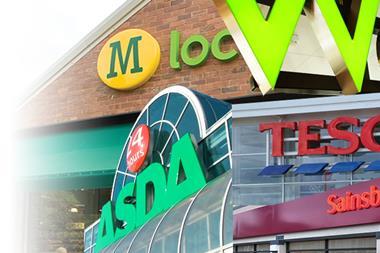Could supermarkets actually start to close in the UK?

Until recently, such a prospect was unthinkable. Even now, according to CBRE, there is 30m sq ft of property in the UK with planning consent to become grocery stores.
However, the second half of 2014 has laid bare the brutal realities facing Britain’s grocery retailers and left chief executives in no doubt that they have to act.
Before this year, the changes taking place in how Britons bought food and the strategic blunders of the “big four” supermarkets had been masked by food price inflation. This ensured that revenues continued to rise.
However, with food prices now falling, the tumbling volumes in supermarkets are clear to see. The latest industry figures from Kantar show that spending in grocery stores fell by 0.2% in the 12 weeks to 9 November, the first decline ever to be reported.
This has led to some damning assessments of the biggest companies in the grocery industry. Waitrose boss Mark Price said it was “incredibly hard to call” whether all of Britain’s food retailers would survive and that supermarkets would follow in the footsteps of non-food businesses by withdrawing space from the market.
Analysts at Goldman Sachs then went even further by warning that Tesco, Sainsbury’s and Morrisons, the listed players, must close 20% of space. This, the analysts said, is the only viable route back profitable growth.
These are not idle threats. The bare facts suggest the big four have built too many supermarkets. Justin King, the former boss of Sainsbury’s, is fond of sharing the fact that since Tesco’s market share peaked in 2007 it has opened enough new stores to cover the same space as the whole of Morrisons today.
But overcapacity is a problem for the industry as a whole. The analysts at Goldman Sachs claim that between 2005 and 2013 Tesco, Sainsbury’s and Morrisons expanded their capacity by 50%, despite UK grocery sales only growing by 32%.
It will take a brave chief executive to start closing stores. However, with a new generation of top bosses emerging thanks to arrival of Dave Lewis at Tesco and Mike Coupe at Sainsbury’s, the slate is clean for them to take drastic action.
Mothballing unfinished developments
Both men have already moved one step closer to closing stores by mothballing unfinished developments. Tesco scrapped one store in Chatteris, Cambridgeshire, that had already been built and another in Margate, Kent, that it had spent years fighting for.
Earlier this month, Coupe claimed there was an “imbalance” of supply and demand equivalent to roughly 15% in the UK. As a result, Sainsbury’s warned that one in four of its shops was under-utilised and scrapped plans to build 40 new stores over the next five years, at some considerable cost.
That write-off gives an indication of the costs at stake here, in terms of the capital value of supermarkets and the price to pull out of leases. More than 60% of the big four’s supermarkets are owned rather than leased, which means food retailers potentially have more flexibility to close shops than non-food retailers who are more likely to rent.
However, those which are leased are tied into 25-year deals and are only likely to have been signed during the space race over the last decade. In addition, closing a wholly-owned shop will result in punishing writedowns on the retailer’s balance sheet.
This means that, certainly at first, the retailers are more likely to look for alternative uses for their stores rather than closing them.
So, expect to see deals to sublet space to B&M or other fast-growing out-of-town retailers. But also, expect to see the big four looking for deals to sell supermarkets to housing developers. Is there a better way of closing a supermarket than to tell the local community you are helping to solve Britain’s housing shortage instead?
Graham Ruddick is retail correspondent for the Daily Telegraph and Sunday Telegraph.
































No comments yet